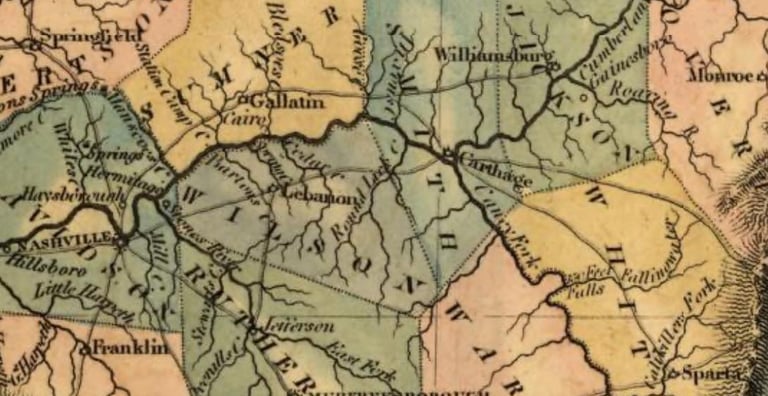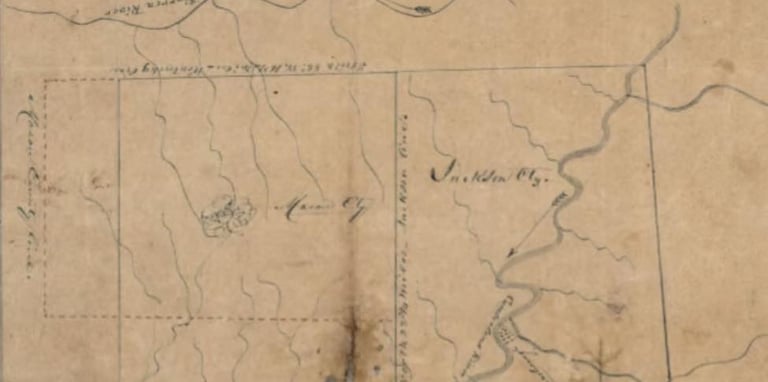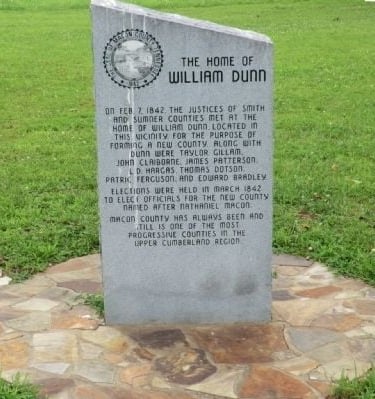Establishing Macon County: Chapter 45 (Sections 1-4)
This is a deep dive into Chapter 45 of the Private Acts of 1841-42 in the Tennessee General Assembly. This chapter officially formed Macon County from Smith and laid the groundwork for its boundaries, governance, and more!
EARLY MACON COUNTYFORMATIONBOUNDARIES


We discussed previously the bill that would create Macon County from Smith and Sumner County. This was done through Chapter 45 of the Private Acts of 1841-42 of the Tennessee General Assembly. What exactly are "private acts"? Private Acts are bills that are passed by the Tennessee General Assembly that only pertain to one county or locality, not the state in its entirety. Chapter 45 of the Private Acts of 1841-42 was the directive to formally create and establish Macon County. It outlined explicitly how it was to happen, what steps would be taken, and how the county would more forward into self-governance. Here, we will explore the first nine sections of Chapter 45 and what they mean!
SECTION 1. That a new county shall be established, to be known and distinguished by the name of Macon, to be composed of parts of the counties of Smith and Summer, beginning at a White Oak, the North-east corner of Smith county, and North-west corner of Jackson county, on the Kentucky line, running thence South with said line, fourteen miles and two hundred and sixty perches to a stake in Neal Carver's field, on Wartrace creek, thence West crossing the head of Defeated creek near John Carter's and Peyton's creek, below Joseph Cocker's and the East fork of Goose Creek, North of Brevard's, and the Middle fork of Goose creek, North of Mungle's, the West fork below Sloan's, thence on to a Mulberry tree near Richard Hickerson's farm, making twenty-three miles and three-quarters. Thence North, running East of said Hickerson's farm, fourteen miles and two hundred and sixty perches to a large white oak, West of Big Trammell creek on the Kentucky line, thence East with said line to the beginning.
Section 1 outlines the boundaries that were to be formed for the new county. The county would initially be rectangular at 23 and three-quarters miles long and 14 and two hundred and sixty "perches" wide (a perch was 16.5 feet, so 260 perches was 4,290 feet total). You can see here a hand-drawn map of those original boundaries and also compare those to the boundaries of today! There have been 12 technical changes of the boundaries of Macon County since its original structure, giving us the unique shape we know and see today. (You will be able to explore these changes in later posts, look for posts in the "boundaryies" category!)


SECTION 2. That for the due administration of justice, the different Courts to be holden in said county of Macon, shall be holden at the house of Wm. Dunn, in the county of Macon, until the seat of justice for said county shall be located, and a suitable house erected for that purpose, and the County Court in the intermediate time shall have full power to adjourn to such other place, in the said county, as they may deem better suited for such holding of the same, and for public convenience, and to adjourn to the seat of justice whenever in their judgment the necessary arrangements are made, and all writs and other precepts returnable to either place, shall and may be returned to the place where said courts may have been removed by the County Court aforesaid, and the said courts to be holden in and for said county of Macon, shall be under the same rules, regulations and restrictions, and shall have, hold and exercise and possess the same powers and jurisdiction, as are possessed by said courts in other counties in this State.
When Macon County was first formed, it did not yet have a courthouse or an established county seat, so the law directed that all courts be held temporarily at the home of William Dunn. Until a permanent “seat of justice” was chosen and a proper courthouse was built, the County Court had the authority to move court sessions to any other location within the county that they felt was more suitable or convenient for the public. All legal documents could be returned to whichever temporary location the court selected, ensuring that government business could continue smoothly during this early period. Overall, this section shows that Macon County began with very limited infrastructure and had to operate in a flexible, makeshift way until its government center was officially established, just like other newly formed Tennessee counties of the time.
SECTION 3. That all officers, civil and military, in said county, shall continue to hold their offices and execute all the powers and functions thereof until others be elected under the provisions of the Constitution and laws made in pursuance thereof, and it shall be the duty of the County Court of Macon, at their first term, to appoint some suitable person to open and hold elections in each civil direct in said county, on the first Saturday in March next, for the purpose of electing county officers, which election shall in all respects, be conducted agreeable to the existing laws regulating elections in other counties in this State. The County officers so elected shall have the same jurisdiction, powers and emoluments that other county officers are entitled to under the existing laws; and the said county of Macon shall be placed on an equal footing, possess equal powers and privileges, in all respects, as other counties in this State: Provided, nothing in this act contained shall be so construed as to prevent the counties of Smith and Sumner from having, holding and exercising jurisdiction over the territory composing the said county of Macon, and the citizens thereof, in as full and ample a manner as they now have, until the election of county officers: Provided, also, that nothing in this act contained, shall be so construed as to prevent the counties from selling, under such judgments, any lands within said county of Macon, for taxes, costs or charges, for the present or any preceding year; nor to prevent the Sheriffs of either of said counties from collecting from the citizens of said county of Macon, any taxes due for the present or any preceding year.
This section explains that when Macon County was created, all existing civil and military officers serving the area would continue in their roles until new officers could be elected according to Tennessee law. At its first meeting, the new County Court of Macon was required to appoint someone to organize elections in each district, to be held on the first Saturday in March, so that official county officers could be chosen just like in other Tennessee counties. Once elected, these officers would have the same powers, responsibilities, and benefits as officers elsewhere in the state, placing Macon County on equal footing with all other counties. Until those elections took place, however, the counties from which Macon was formed—Smith and Sumner—would still retain full legal authority over the territory and its citizens. This section also clarifies that both counties could continue collecting any taxes already owed and could enforce judgments or sell land within the new county for unpaid taxes or costs from previous years. Overall, it shows that Macon County went through a transition period where it relied on its parent counties for legal and financial matters until its own government was formally elected and functioning. Section 4 simply stated that those who lived in Macon County, would vote for their Governor, Congressmen, and General Assembly in the counties from which they were taken from. Therefore, if your farm was in Sumner County previously, you placed those votes in Sumner County. Section four reads as follows:


This marker was erected to mark the location of the home of William Dunn, where the first Court of Macon County was held and essentially where the county was organized. Located on Old Hwy 52 in front of the National Guard Armory.
SECTION 4. That the citizens of the county of Macon, in all elections for Governor, for members of Congress, and for members of the General Assembly, shall vote with the counties from which they may have been stricken off, until the next apportionment of members of the General Assembly agreeably to the Constitution.
This is where we will stop in this exploration of Sections 1-4 of the Private Acts of 1841-42. These first four sections described how the county would initially be governed, as well as it's original boundaries. In Part 2, we will explore sections 5 through 10, which will lay the groundwork for the county seat, its location, design, and its initial structure.
Written by: Caleb Fleming, Macon County History Preservation Project
